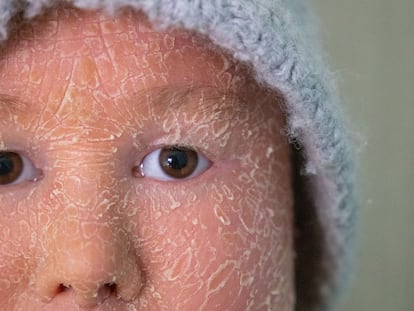Doctors awed at ‘unique’ patient who has been living HIV-free for over 15 years without medication
A team of researchers from Barcelona has studied the cellular mechanism that allowed a woman to be ‘functionally’ cured despite not taking antiretrovirals
A Spanish woman with HIV has been controlling the virus for more than 15 years without taking medication. Her viral load is now undetectable; her case has been described as “unique” and “exceptional,” as she has essentially been cured of the disease.
The study of this patient – whose identity and age have not been disclosed to protect her anonymity – has been conducted by a team of doctors from the Hospital Clinic of Barcelona, in northeastern Spain. The case will be presented at the 24th International AIDS Conference in Montreal, Canada, which opened on Friday.
“This lady has been [living] without medication for more than 15 years. After spending a short period of time with her, [we’ve discovered] that [her body] fully controls the AIDS virus,” said Dr. Josep Mallolas, head of the Clinic’s HIV-AIDS Unit, during a press conference,
The HIV infection is a pandemic that affects nearly 38 million people. AIDS – the most advanced stage of the infection – kills 650,000 patients each year. Four decades of scientific advances have managed to save millions of infected people thanks to antiretroviral therapy (ARV), a cocktail of drugs that prevents the replication and transmission of the virus. This is the only treatment available for the vast majority of carriers of HIV, a virus that destroys the immune system. Today, more than 28 million seropositive people can lead a normal, quality life thanks to a daily pill.
However, a definitive cure has not yet been found. Although antiretrovirals are effective in suppressing viral replication, HIV persists. The disease recovers strength after the discontinuation of therapy. There are very few exceptions: a few people who are called “aftercare controllers” are able to keep the virus at bay when medication is withdrawn. In addition, there are also so-called “elite controllers” who achieve the same effect, despite not having started antiretroviral therapy. These cases represent less than 1% of all infected individuals.
The woman – who is being referred to as the “patient from Barcelona” – does not belong to the aforementioned groups. She was diagnosed in 2006 with an acute infection, something that is not typical in aftercare or elite controllers. She was subsequently included in a clinical trial led by Dr. José M. Miró, whose objective was to find out if the immune system could be strengthened so that it could control viral replication. Of a cohort of patients, one group received only antiretrovirals; the other received a series of additional immunomodulatory treatments, including an immunosuppressant called cyclosporine. This immunosuppressant is described as “HIV in plasma,” by Dr. Núria Climent, a researcher with the AIDS and HIV infection group at the Hospital Clinic of Barcelona.
“After nine months from when the treatment was interrupted, HIV was no longer detected in [this] patient’s blood,” Climent notes. In fact, this woman was the only one out of the 20 individuals in the trial who reacted like this.
“The virus did not rebound, and it has not rebounded after 15 years and more than 50 viral load tests.” It was as if, for the first time, the doctors and researchers were witnessing the unmitigated victory of the immune system over the virus.
The Barcelona patient is unique, because there are very few people whose bodies are able to control HIV so many years after stopping treatment. “If we were able, through treatment, to repeat or replicate that innate immune capacity that this woman has, the advantages would be enormous,” Dr. Mallolas explains.
The researchers emphasize that the patient from Barcelona is functionally cured. That is, without any type of treatment, her body controls the replication of HIV… but this doesn’t mean that the virus has ceased to exist inside her body. When her cells are analyzed, there is a viable virus capable of causing new infections. For this reason, hers is a different case from that experienced by a handful of patients receiving experimental treatments in London and Berlin. The latter group of individuals completely eliminated HIV from their bodies thanks to bone marrow transplants.
Dr. Juan Ambrosioni, a doctor at the Clinic’s HIV-AIDS unit, stresses that this measure is very aggressive. “You can’t use it for the almost 40 million people living with HIV. On the other hand, if you manage to detect a group with a certain genetic substrate that, through certain interventions, can spontaneously control the virus, you would be doing something potentially much easier to scale.”
Next steps
The next step in this research is to identify exactly what combination of factors specific to the female patient led to this control over the virus. The idea is to replicate the conditions that the other participants in the clinical trial did not have.
“It’s very important to study [the patient] in depth. Once we completely understand her cells and immunity, we will be able to design research projects for others. While we may not be able to cure them, we can find a way for them to manage to live without treatment, with an undetectable viral load and without the possibility of being contagious. A fascinating range of research possibilities is opening up,” Mallolas confirms.
One of the next stages of research is to analyze the rest of the clinical trial cohort to compare the patient from Barcelona with the other participants.
“This cohort is going to give us a lot of information about whether the treatment did something special to her and not to the others, or if it did it to everyone and they only needed to have certain genetic factors to trigger it,” says Dr. Climent.
Researchers from the Hospital Clínic-IDIBAPS/University of Barcelona, the Infectious Diseases Network Biomedical Research Center (CIBERINFEC), the Germans Trias i Pujol Hospital and the Carlos III Health Institute have participated in the follow-up to the case study. In the best scenario, the team aspires to achieve a definitive cure for the woman. At worst, she may need antiretroviral therapy again.
“You have to be very careful… we could have 15 years of success, but not 16,” Mallolas warns.
Advanced age can also be a negative factor. Dr. Climent says that they do not know how aging may affect the patient’s health situation five or 10 years from now, but given that the patient has normal immune levels and has not suffered any health problem in the last 15 years, there is reason to hope for the best.
Little is known about the patient from Barcelona since she has requested to remain anonymous. It is only known that she is in excellent health and her immune system and tests are perfectly normal. Mallolas describes her as a person who has given “everything” for science.
“She is super collaborative and this is to be appreciated… there are many volunteers in the world of HIV who go unnoticed and who are, however, the ones who allow studies like this to be carried out.”
Tu suscripción se está usando en otro dispositivo
¿Quieres añadir otro usuario a tu suscripción?
Si continúas leyendo en este dispositivo, no se podrá leer en el otro.
FlechaTu suscripción se está usando en otro dispositivo y solo puedes acceder a EL PAÍS desde un dispositivo a la vez.
Si quieres compartir tu cuenta, cambia tu suscripción a la modalidad Premium, así podrás añadir otro usuario. Cada uno accederá con su propia cuenta de email, lo que os permitirá personalizar vuestra experiencia en EL PAÍS.
¿Tienes una suscripción de empresa? Accede aquí para contratar más cuentas.
En el caso de no saber quién está usando tu cuenta, te recomendamos cambiar tu contraseña aquí.
Si decides continuar compartiendo tu cuenta, este mensaje se mostrará en tu dispositivo y en el de la otra persona que está usando tu cuenta de forma indefinida, afectando a tu experiencia de lectura. Puedes consultar aquí los términos y condiciones de la suscripción digital.
More information
Últimas noticias
Most viewed
- Reinhard Genzel, Nobel laureate in physics: ‘One-minute videos will never give you the truth’
- Oona Chaplin: ‘I told James Cameron that I was living in a treehouse and starting a permaculture project with a friend’
- Pablo Escobar’s hippos: A serious environmental problem, 40 years on
- Why we lost the habit of sleeping in two segments and how that changed our sense of time
- Charles Dubouloz, mountaineering star, retires at 36 with a farewell tour inspired by Walter Bonatti










































